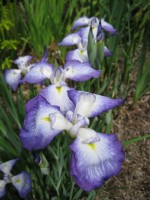 The Japanese have spent over 500 years breeding this beardless iris and have created a spectacular flower that are very different from those of the more familiar German or Siberian iris. They are large (up to 10” across) and relatively flat looking more like dinner plates than traditional iris. This is due to the fact that the 3 upright petals (standards) are virtually eliminated and the 3 lower petals (falls) have become larger. Single cultivars have 3 broad, overlapping petals, while doubles have 6 petals, and peony-style flowers have up to 12. All cultivars need abundant moisture in spring when preparing to bloom but can tolerate drier conditions after blooming. Some cultivars are tall and can be placed at the back of a border and all look lovely around ponds or along waterways. Plant in spring or fall.
The Japanese have spent over 500 years breeding this beardless iris and have created a spectacular flower that are very different from those of the more familiar German or Siberian iris. They are large (up to 10” across) and relatively flat looking more like dinner plates than traditional iris. This is due to the fact that the 3 upright petals (standards) are virtually eliminated and the 3 lower petals (falls) have become larger. Single cultivars have 3 broad, overlapping petals, while doubles have 6 petals, and peony-style flowers have up to 12. All cultivars need abundant moisture in spring when preparing to bloom but can tolerate drier conditions after blooming. Some cultivars are tall and can be placed at the back of a border and all look lovely around ponds or along waterways. Plant in spring or fall.
Type: Herbaceous perennial.
Bloom: Large (up to 10” diameter) white, blue, pink, purple, or lavender between late spring to mid summer (weeks after German and Siberian iris).
Size: 24-48” H x 24” W.
Light: Full sun to partial shade.
Soil: Organic-rich, acid, moisture retentive soil. DO NOT use lime near these iris.
Hardiness: Zones 4-9.
Care: Cut back foliage to 6” in fall. Divide every 3-5 years when flower number or size diminish.
Pests and Diseases: No serious problems but roots susceptible to rot in the winter if the plant is grown in boggy or wet conditions.
Propagation: Division or offsets in spring or fall.
Companion plants: Astilbe, heuchera, garden phlox.
Outstanding Selections: Many excellent cultivars are available but here are some of the classics.
 ‘Cry of Rejoice’ (yellow centered deep purple)
‘Cry of Rejoice’ (yellow centered deep purple) ‘Eleanor Perry’ (purple veined violet)
‘Eleanor Perry’ (purple veined violet) ‘Great White Heron’ (semi double, pure white)
‘Great White Heron’ (semi double, pure white) ‘Pink Frost’ (Double, 8” wide, light pink, ruffled)
‘Pink Frost’ (Double, 8” wide, light pink, ruffled) ‘Variegata’ – Purple flowers, leaves with white variegation.
‘Variegata’ – Purple flowers, leaves with white variegation.